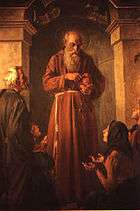Conrad of Parzham
| St. Conrad of Parzham, O.F.M. Cap. | |
|---|---|
 | |
| Born |
22 December 1818 Bad Griesbach, Passau, Kingdom of Bavaria |
| Died |
21 April 1894 Altötting, Kingdom of Bavaria |
| Venerated in |
Roman Catholicism (Franciscan Order) |
| Beatified | 1930 by Pope Pius XI |
| Canonized | 1934 by Pope Pius XI |
| Feast | 21 April |
Saint Conrad of Parzham, O.F.M. Cap. (1818 – 1894), was a German Franciscan lay brother. He served for over 40 years in the post of porter of the Capuchin friary in Altötting, through which work he gained a widespread reputation for his wisdom and holiness. He has been declared a saint by the Catholic Church.
Life
Early life
Born 22 December 1818,[1] he was baptized with the name of John, the son of Bartholomäus Birndorfer and Gertrude Niedermayer, and was born on the family farm in Bad Griesbach, now a part of the town of Parzham, then in the Kingdom of Bavaria, now part of Germany. He was the ninth son in a peasant family.
From his earliest years, the young Hansel (a diminutive of John) gave indications of his future sanctity by his modesty and love of solitude. His devotion was noticeable especially when he prayed in church, the distant location of which was no hindrance to his visiting it frequently even in inclement weather. He had a great devotion to the Blessed Virgin, and each day fervently recited the Rosary. On feast days he frequently made a journey to some remote shrine of the Blessed Mother. During such pilgrimages, always made on foot, he was engaged in prayer, and when he returned in the evening, he was usually still fasting.
John spent his early years on the family farm, losing his mother when he was 14. At the age of 31, after his father's death, he decided to leave the secular world. After disposing of his inheritance, he was admitted, first as a tertiary, then, two years later, as a lay brother among the Capuchin Franciscan friars.[2] Upon entering the novitiate, he was given the name Conrad by which he was known for the remainder of his life.
Brother Porter
Immediately after his profession he was sent to the Friary of St. Ann, in the city of Altötting. The friary served the Shrine of Our Lady of Altötting, the national shrine of Bavaria to the Blessed Mother. Conrad was given the position of porter at this shrine, and retained it until his death. Because it was a large and busy city, the duty of the friary porter was a very difficult one. Conrad was known to be diligent at his work, sparing in words, bountiful to the poor, eager and ready to receive and help strangers. Brother Conrad fulfilled the task of porter for more than forty years, assisting the inhabitants of the town in their needs of body and soul.
Conrad loved silence in a special way. His spare moments during the day were spent in a nook near the door where it was possible for him to see and adore the Blessed Sacrament. During the night he would deprive himself of several hours of sleep, to devote the time to prayer either in the oratory of the friars or in the church. It was generally believed that he never took any rest, but continually occupied himself in work and exercises of devotion.
On the 21 April 1894, Conrad died in the friary where he had served for 41 years.
Canonization
During his lifetime, Brother Conrad was reputed to have been able to read the hearts of those he met, and was attributed the gift of prophecy.[3] His heroic virtues and the miracles he performed won for him the distinction to be ranked among the Blessed by Pope Pius XI in 1930. Four years later, the same pope, approving additional miracles which had been performed, solemnly inscribed his name in the list of saints.
References
- ↑ Saints.SQPN
- ↑ SQPN
- ↑ Farmer, David Hugh (1997). The Oxford dictionary of saints (4. ed.). Oxford [u.a.]: Oxford Univ. Press. pp. 114–115. ISBN 0-19-280058-2.
External links
| Wikimedia Commons has media related to Saint Conrad of Parzham. |
![]() This article incorporates text from a publication now in the public domain: Herbermann, Charles, ed. (1913). "article name needed". Catholic Encyclopedia. New York: Robert Appleton.
This article incorporates text from a publication now in the public domain: Herbermann, Charles, ed. (1913). "article name needed". Catholic Encyclopedia. New York: Robert Appleton.